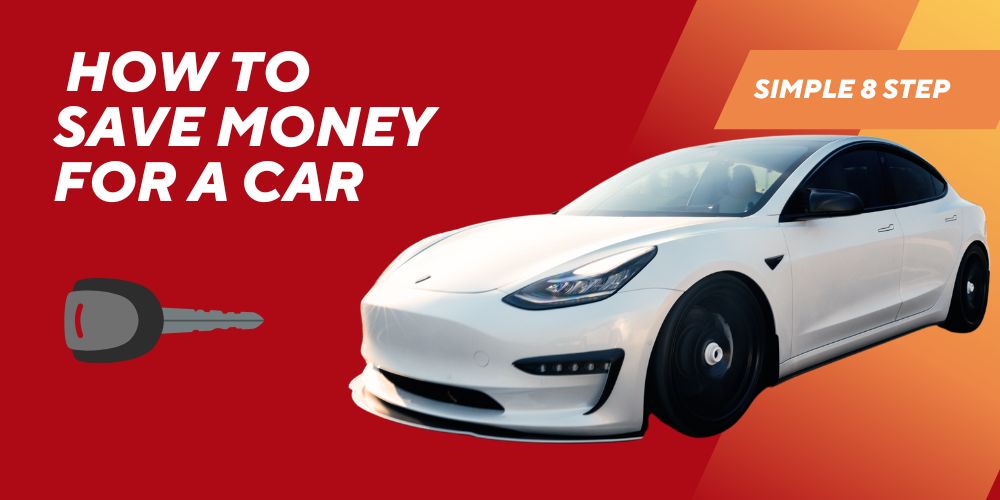
How To Save Money For A Car: A Step-By-Step Plan
Posted on |
How To Save Money For A Car – Last Updated [April 2025]
Buying a car is a significant financial commitment, whether you’re purchasing a brand-new vehicle or a used one. Proper planning and disciplined saving can help you afford the car you want without putting a strain on your finances. Here’s a step-by-step guide on how to save money for a car efficiently.
Simple 8 Steps: How To Save Money For A Car

Step 1: Determine Your Budget
Before you start saving, you need to determine how much money you’ll need. Consider the following:
- New Vs Used Car: A used car is usually cheaper and depreciates less than a new car.
- Total Cost: Factor in the purchase price, taxes, registration fees, and insurance costs.
- Down Payment: If you’re financing the car with a loan, aim for at least a 20% down payment on a new car or 10% on a used car to reduce loan costs.
- Cash Purchase Vs Loan: Decide if you want to pay in full or finance the car with a loan. A cash purchase saves on interest but requires more upfront money.
Pro Tip: If you plan to buy a car worth $15,000, saving for a 20% down payment ($3,000) will lower your monthly loan payments.
Step 2: Set A Savings Goal
Once you have a budget, set a realistic savings goal.
- Decide how soon you want to buy the car (e.g., 12 months, 24 months).
- Break down the total amount into monthly or weekly savings.
Example Goal Breakdown:
- Target: $10,000 (for a used car)
- Timeframe: 12 months
- Monthly savings required: $833 per month
- Weekly savings required: $208 per week
Step 3: Create A Dedicated Savings Account
To keep your car savings separate from your everyday spending, open a high-yield savings account or a separate bank account.
Benefits Of A Dedicated Savings Account:
- Avoids accidental spending.
- Earns interest over time.
- Helps track your progress.
Pro Tip: Consider an automatic transfer to your savings account each month to stay consistent.
Step 4: Cut Expenses & Increase Savings
If your current income isn’t enough to reach your goal, look for ways to cut expenses and save more.
Ways To Reduce Expenses:
- Eat out less: Cook meals at home instead of dining out.
- Cancel unused subscriptions: Streaming services, gym memberships, etc.
- Reduce impulse purchases: Stick to a shopping list.
- Buy generic Brands: Save on groceries and household items.
- Use Public Transportation: Save on gas and reduce wear on your current vehicle.
Ways To Boost Your Savings:
- Sell Unused Items: Electronics, clothes, furniture, or an old car.
- Freelance Or Part-Time Work: Online gigs, tutoring, delivery jobs, etc.
- Cut Down On Luxury Expenses: Delay vacations, avoid expensive hobbies, etc.
Step 5: Look For Additional Income Sources
If cutting expenses isn’t enough, explore additional income sources:
- Side Hustles: Freelancing, blogging, or reselling products.
- Overtime Or Extra Shifts: If available at your current job.
- Gig Economy Jobs: Uber, DoorDash, etc.
Step 6: Monitor Your Progress
Track your savings regularly to stay motivated.
- Use budgeting apps like Excel spreadsheets.
- Check your savings account balance monthly.
- Adjust your plan if needed (increase income, extend your timeline, or lower your goal).
Example: If you are falling behind, consider delaying your purchase by 3–6 months to ensure financial stability.
Step 7: Consider Financing Options (If Needed)
If you cannot save the full amount, explore financing options:
Auto Loans:
- Check interest rates from different lenders.
- Maintain a good credit score to get better loan terms.
- Choose a shorter loan term (3-5 years) to save on interest.
Leasing Vs Buying:
- Leasing can lower monthly payments but costs more in the long run.
- Buying gives full ownership and better resale value.
Pro Tip: Get pre-approved for a loan before visiting a dealership to negotiate better terms.
Step 8: Shop Smart & Negotiate
Once you reach your savings goal, be strategic in purchasing your car:
- Compare Prices: From multiple dealerships and private sellers.
- Check For Discounts: Military, student, or first-time buyer incentives.
- Negotiate: Dealers expect buyers to negotiate; don’t accept the first price.
- Get a Pre-Purchase Inspection: (for used cars) to avoid costly repairs.
Best Time To Buy: End of the month, end of the year, or during holiday sales (e.g., Black Friday, Labor Day).
Conclusion:
Owning a car is a significant financial milestone, and saving for it responsibly ensures that you avoid unnecessary debt and financial stress. By following this step-by-step plan, you can accumulate the necessary funds while maintaining financial stability. The key is to remain patient, stay committed to your savings goal, and make informed purchasing decisions. Once you’ve saved enough, take the time to research, negotiate, and buy a car that fits your needs and budget. In the end, your effort will pay off, giving you the freedom and convenience of car ownership without the burden of financial strain.
FAQ’s
Q. How much should I save before buying a car?
It depends on whether you’re paying in full or financing. Ideally, save at least 20% for a new car or 10% for a used car as a down payment.
Q. How can I save money faster for a car?
Cut unnecessary expenses, increase your income through side gigs, and set up automatic savings in a dedicated account.
Q. Is it better to buy a car with cash or finance it?
Paying cash avoids interest, but financing helps spread out the cost. If you take a loan, aim for a shorter term and low interest rates.
Q. What are the hidden costs of buying a car?
Besides the purchase price, consider taxes, registration fees, insurance, maintenance, and fuel costs.
Q. When is the best time to buy a car for the best deals?
The end of the month, end of the year, or major sales events (like Black Friday or Labor Day) often offer the best discounts.

